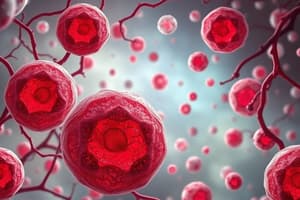Podcast
Questions and Answers
What is the primary function of albumin in plasma?
What is the primary function of albumin in plasma?
- It serves as a carrier molecule for other substances. (correct)
- It directly transports respiratory gases.
- It aids in the production of erythrocytes.
- It assists in the immune response.
Which characteristic is NOT true about erythrocytes?
Which characteristic is NOT true about erythrocytes?
- They contain hemoglobin.
- They can replicate themselves in the blood. (correct)
- They possess a flexible and elastic structure.
- They lack mitochondria.
Which type of cell is classified as a formed element in blood?
Which type of cell is classified as a formed element in blood?
- Electrolytes
- Plasma proteins
- Neutrophils (correct)
- Nutrients
What is the lifespan of platelets in the bloodstream?
What is the lifespan of platelets in the bloodstream?
Which white blood cell type primarily acts as a phagocyte?
Which white blood cell type primarily acts as a phagocyte?
In leukopoiesis, what is the primary site of white blood cell formation?
In leukopoiesis, what is the primary site of white blood cell formation?
Which of the following describes the function of macrophages in the immune system?
Which of the following describes the function of macrophages in the immune system?
How does the biconcave shape of red blood cells benefit their function?
How does the biconcave shape of red blood cells benefit their function?
What is the normal red blood cell count range per microliter?
What is the normal red blood cell count range per microliter?
Which of the following substances is NOT found in plasma?
Which of the following substances is NOT found in plasma?
Flashcards are hidden until you start studying
Study Notes
Hematopoiesis and Blood Cell Production
- Blood cells are derived from hematopoietic stem cells.
- Chemical signals like interleukins and Colony Stimulating Factors (CSF) promote differentiation.
- Granulocytes are stored in bone marrow, with a ratio of 10 times more than in blood.
- Production ratio: three white blood cells (WBCs) for every red blood cell (RBC), with WBCs having a shorter lifespan (0.25 – 9 days).
Types of White Blood Cells
- Granulocytes include:
- Neutrophils: 50-70%
- Eosinophils: 2-4%
- Basophils: 0.5-1%
- Agranulocytes include:
- Lymphocytes: 20-25%
- Monocytes: 3-8%
Differential White Blood Cell Count
- Evaluating 100 WBCs gives the following range for percentages and absolute numbers (x10^9 cells/L):
- Neutrophils: 50-70%, 1.7 – 7.5
- Lymphocytes: 20-25%, 1.0 – 3.2
- Monocytes: 3-8%, 0.2 – 0.6
- Eosinophils: 2-4%, 0.03 – 0.06
- Basophils: 0.5-1%, 0.02 – 0.29
- Mnemonic for abundance: "Never Let Monkeys Eat Bananas" (Neutrophils > Lymphocytes > Monocytes > Eosinophils > Basophils).
Phagocytosis
- Macrophages engage in phagocytosis, wherein they adhere to and engulf pathogens or debris.
Blood Homeostasis
- Homeostasis is regulated mainly by negative feedback systems.
- RBCs have a lifespan of 100-120 days but degrade due to the inability to synthesize new proteins.
- Inflexible RBCs become trapped in the spleen where they are engulfed by macrophages.
- Iron from hemoglobin is recycled, while the remainder is degraded to bilirubin.
Erythropoiesis and RBC Production
- Erythropoiesis occurs in bone marrow, where Hb is produced and the nucleus is ejected.
- Production is regulated by negative feedback, primarily in response to hypoxia, stimulated by erythropoietin.
- Old RBCs are primarily degraded in the spleen, liver, and bone marrow, recycling many components.
Leukocytes Overview
- Leukocytes constitute ~1% of total blood volume, with a count of 5,000 to 10,000 cells per µl of blood.
- Total leucocyte count averages between 5-9 x 10^9 cells/mL.
- Their primary function is to combat pathogens, with only 2% residing in the blood.
Plasma Composition
- Plasma is approximately 90% water and 10% solutes, containing over 100 different dissolved substances.
- Major components include plasma proteins (60% of which is albumin), nutrients, enzymes, hormones, electrolytes, and respiratory gases.
Formed Elements of Blood
- Formed elements include leukocytes, platelets (buffy coat), and erythrocytes.
- Erythrocytes are not true cells as they lack nuclei and organelles.
- Platelets are cell fragments and do not divide, originating from stem cells in the bone marrow.
Red Blood Cells (Erythrocytes)
- Normal RBC count ranges from 4.2 to 6.1 million/µl.
- RBCs are 7-8 µm biconcave disks, maximizing surface area for gas exchange.
- They have a plasma membrane but lack a nucleus, organelles, and mitochondria, producing energy anaerobically.
- They consist of 97% volume of hemoglobin, serving as carriers for oxygen.
Blood Smear Visualization
- A blood smear using Leishman’s stain provides a microscopic view of blood cell types.
Studying That Suits You
Use AI to generate personalized quizzes and flashcards to suit your learning preferences.




